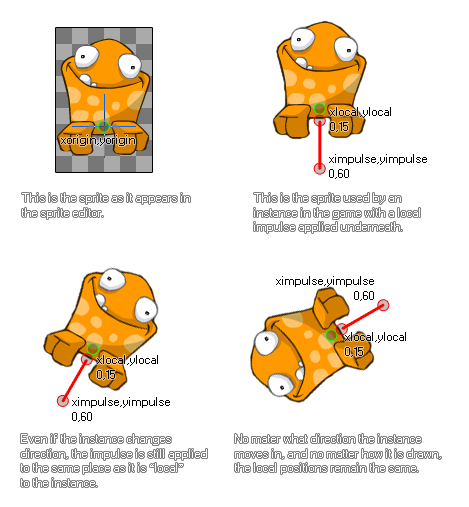
physics_apply_local_impulse(xpos, ypos, ximpulse, yimpulse)
| Argument | Description |
|---|---|
| xpos | The x coordinate relative to the origin where the impulse will be applied |
| ypos | The y coordinate relative to the origin where the impulse will be applied |
| ximpulse | the x component of the impulse vector (relative to the xpos coordinate) |
| yimpulse | the y component of the impulse vector (relative to the ypos coordinate) |
Returns: N/A
Not only can you apply force and gravity to an object with the
physics in GameMaker: Studio but you can also apply an
impulse. This is slightly different to a force in that when it is
applied it will immediately affect the speed, and,
potentially the torque (or "spin") of the object, particularly if
the point chosen to apply the impulse has a vector that is not
aligned with the centre of mass (note: the center of mass is not
necessarily the same as the origin!). This function applies an
impulse locally to an instance. What this means is that the
strength and direction of the impulse are calculated based on the
origin (or the position if it has no sprite) of the instance,
without taking into consideration the direction or rotation it may
have in the game room or physics world. Here is an
illustration:

As you can see, the frog in the image gets an impulse from below
to make it "jump". The exact impulse is defined by the vector we
get from the components ximpulse/yimpulse in relation to the
xpos/ypos coordinates - which simply means that the impulse is
calculated as the distance from xpos/ypos to ximpulse/yimpulse in
Newtons, and the direction is the angle that we get from xpos/ypos
to ximpulse/yimpulse.
NOTE: The physics world uses metres for all its
calculations, and the ratio of pixels per metre is defined in the
room editor or using physics_world_create.
if jump physics_apply_local_impulse(0, 20, 0, 50);
The code above will apply an impulse with force of 30 Newtons and a direction going from bottom to top relative to the instance origin if the variable "jump" is true.